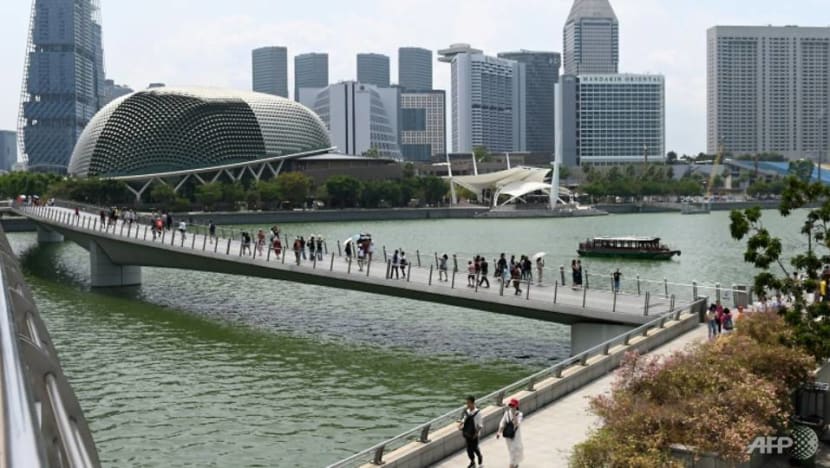Singapore's mean sea level may rise by up to 1.15m by 2100, exceeding previous estimates
Singapore and the global community are facing an inevitable "locked-in" sea level rise in coming decades, even under a most optimistic scenario of low carbon emissions.

As a low-lying island, Singapore is especially vulnerable to the "grave threat" of rising sea levels, Prime Minister Lee Hsien Loong has warned. (File photo: AFP/Roslan RAHMAN)

This audio is generated by an AI tool.
- The latest study projects a mean sea level rise of up to 1.15m by end-century, higher than previous estimates of 1m
- The study also projects a mean sea level rise of up to 2m by 2150 under the worst case scenario
- Sea level rise is inevitable even if the world cuts carbon emissions as desired
SINGAPORE: Step onto Singapore's shorelines by the end of the century and you might find that sea water has crept landward, eating up a significant portion of the coast.
This might be a reality for some of Singapore's coastline if carbon emissions continue to remain high, and Singapore does not protect its low-lying areas.
According to updated projections from Singapore's third National Climate Change Study released on Friday (Jan 5), the mean sea level around Singapore will rise even higher than previously expected.
The study is based on the United Nations Intergovernmental Panel on Climate Change's (IPCC) sixth assessment report.
Previous projections forecast a mean sea level rise of up to 1m by the end of the century, but this third version of the study has revised the figure to 1.15m.
The study has also gone beyond the end of the century, projecting a mean sea level rise of up to 2m by 2150 under a high carbon emissions scenario. The projected figures are relative to the baseline period of 1995 to 2014.
"Low confidence" sea level projections up to 2300 are also included, an improvement from the second study, which provided medium-confidence sea level projections up to 2100.
Low confidence here indicates a low degree of confidence in the projections being correct, whilst medium confidence here indicates a medium degree of confidence in the projections being correct.
The latest projections are due to better understanding of how melting Antarctic ice sheets contribute to global sea levels.
The average observed mean sea level rise around Singapore is currently around 0.2m across six tide gauges.
Some 30 per cent of Singapore's land lies less than 5m above the mean sea level. With rising sea levels, extreme weather events such as high tides and storm surges are likely to cause levels to spike by a further 4m to 5m.
Faced with this threat, the authorities are already studying ways to protect Singapore's shorelines.
Singapore unveiled one of its most significant measures yet in November last year: Reclaiming land for a new island to protect one of the country's most endangered shorelines.
The island-nation also has in place various other measures, most of which are hard structures such as sea walls and stone embankments, and is in the midst of studying longer-term and more targeted ways to protect coastlines.
Singapore is also developing capabilities to address flood risks and strengthen flood resilience.
All these come at a hefty cost. In 2019, Prime Minister Lee Hsien Loong noted it would take S$100 billion or more, spread over 100 years, to tackle rising sea levels.
As sea-level rises accelerate, addressing when to implement measures will become more important, said Professor of Urban Climate Winston Chow from Singapore Management University.
"As sea-level rise is very likely going to accelerate per the version three analysis, the time window left for implementing these adaptation measures is shrinking faster, which also has implication for the cost of doing so."
"There is still uncertainty over the change in ice mass under (high emissions scenario), and if these ice sheets do melt completely - a low likelihood, but (with) high impact - then there’s no amount of adaptation measures that Singapore can use to protect our coastlines," he added.
HIGHER SEA LEVEL RISE
Sea level projections in the third version of the national climate study "mark a significant advancement" from the second iteration in several "critical aspects", the report noted.
Apart from extending sea level projections up to the year 2150, version three provides projections which are in line with the latest scientific advancements.
The latest report also provides more detailed information by offering projections for six crucial tide gauges around Singapore, compared with the previous version's singular representation.
The stakeholder report pointed to "notable disparities" in both versions, with respect to data collected by the tide gauge with the highest projections, at Sultan Shoal.
Both the median and the upper limit of the likely range of sea level rise at Sultan Shoal in version three exceeded projections in version two by tens of centimetres.
The study noted that this substantial difference - particularly in the context of the Antarctic ice sheet - could be primarily attributed to advancements in modelling introduced in IPCC's sixth assessment report.
This report incorporates more sophisticated ice-sheet models that consider "a wider range of processes and feedback mechanisms", noted the Singapore study.
Key findings on Singapore's sea level rise from the study are based on three climate change scenarios of low, medium and high carbon emissions.
By the end of the century and in the event of low carbon emissions, the increase in mean sea level will be between 0.23m and 0.74m.
Under the medium and high emissions scenarios, the increase is between 0.34m and 0.88m; and 0.54m and 1.15m; respectively.
The forecasts represent data from across the six tide gauges at Sultan Shoal, Sembawang, Raffles Light House, Tanjong Pagar, West Coast and West Tuas.
The upper bound of the forecast average relative sea level rise range for Singapore slightly exceeds the global mean by both 2100 and 2150.
There are two main contributors behind global mean sea level rise: Thermal expansion of ocean waters and mass loss from ice sheets.
However, relative sea level changes around the world are not uniform due to additional factors such as ocean circulation patterns, density changes and vertical land movement.
According to the study, Singapore's higher sea level rises compared with the expected global increase can be primarily attributed to local factors, particularly vertical land movement.
This is the change in the height of the sea floor or the land surface.
Vertical land movement contributes to some degree of the land sinking in Singapore, consequently driving a relative sea level rise.
"More importantly, these projections emphasise a pragmatic reality: Even under the most optimistic low-emission scenarios, both Singapore and the global community are facing an inevitable ‘locked-in’ sea level rise in the coming decades," the stakeholder report said.
Graphics by Clara Ho
Source: Meteorological Service Singapore, Centre for Climate Research Singapore


















